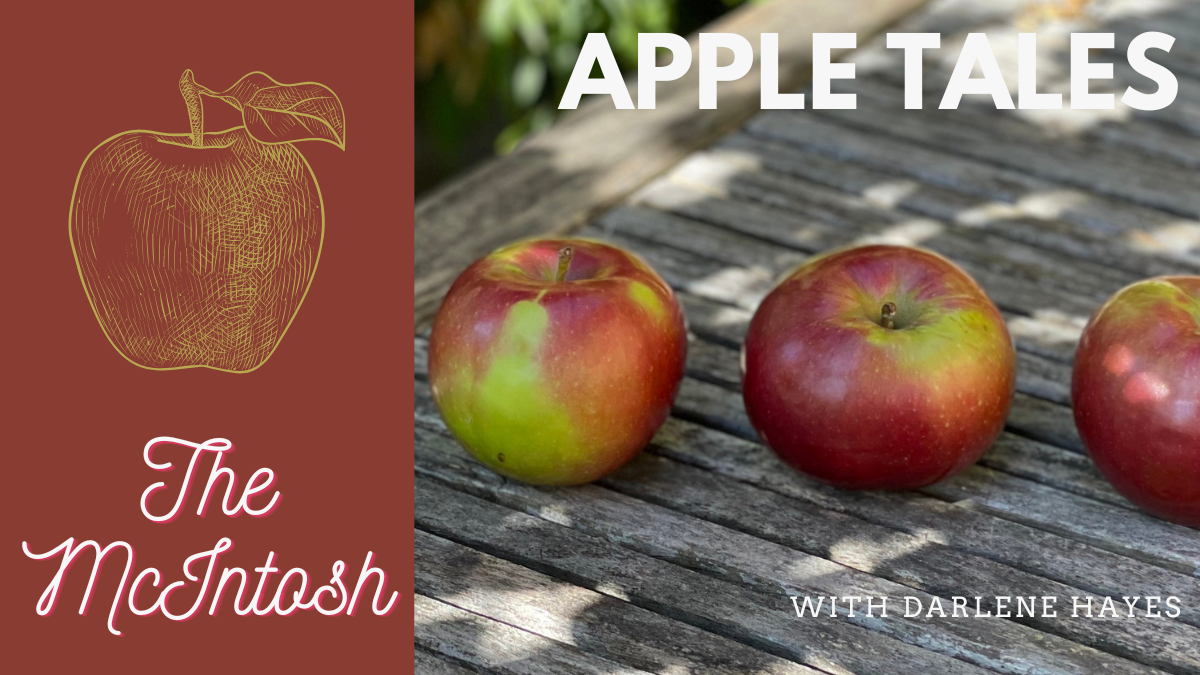Apple Tales with Darlene Hayes
McIntosh is such a familiar apple in the United States, we tend to forget that it came from farther north in Canada. It got its name from John McIntosh (1777-1845), who discovered it growing on land he was clearing near Matilda Township, Ontario, on the St. Lawrence River. He’d arrived there some time in the late 18th or early 19th century from New York’s Mohawk Valley, part of the second wave of European settlers moving into the area.
Known as the McIntosh Red, it remained a local variety until the 1870s, first noted in a handful of articles in northern Vermont newspapers. “A New Apple” trumpeted the headline of a letter written by Guy A. Clough of Braintree, Vermont, to the Vermont Farmer in April 1874. He said that he had accidentally discovered McIntosh Red while traveling in Canada and thought it was so wonderful that he tracked down its source, John McIntosh’s son, Allen.
“Your informant became so much interested in … this tree, that he traveled over a large section of country … in search of rebutting testimony [to its superior qualities], but found none, each affidavit being of the most positive character,” Clough wrote.
The qualities possessed by McIntosh Red would recommend it to any farmer. The trees bore a decent crop every year. The fruits were large with an attractive red color and were reported to keep well into the spring following harvest. But it was the tree’s hardiness and reported resistance to frost damage that seems to have most interested the farmers of Vermont. Winters could be harsh there with temperatures often dropping to -20 F, according to one writer. Many of the popular market apples simply couldn’t handle such severe cold. The papers were soon filled with notices that local nurserymen, including Clough’s son, Storr, had grafted McIntosh Red trees for sale.
Buying ready grafted trees was something of a new phenomenon. For most of U.S. history, farmers had simply either relied on whatever seedlings popped up or converted those seedlings with a graft of a known variety. This started to change in the mid-19th century, as more farmers relied on growing apples with well-known names. The farmer wanting to purchase trees could, then as now, write to a nursery and request a printed catalog of what was available, then mail in an order. But there was another option: the nursery agent. The agent traveled the rural highways, knocking on doors with catalog in hand, taking orders for trees and returning later with the goods. This had tremendous advantages for the rural farmer, giving him access to new and improved varieties that he otherwise might not have known existed, or stock that was otherwise unavailable locally. The system functioned well, provided the nursery agent was an honest one.
This was not always the case. “[A]pparently the great evils the agriculturalist has to deal with are insects and tree-dealers; … and the greatest of these is the tree-dealer,” wrote editor James Vick in Vick’s Illustrated Monthly Magazine, October 1879. There was no guarantee that the trees an agent brought to the farm were actually what was ordered, for example, and it took years before the tree would bear enough fruit to tell one way or the other. Horticultural publications in the late 19th century had many a horror story to relate along these lines. The most reputable nurseries took great pains to ensure that their representatives were trustworthy, giving their agents special catalogs prominently bearing the agent’s name on the cover or official certificates of employment.
These measures must have worked, for despite the problems reported in the press, nursery agents proved to be an enormous boon to both the farmer and nursery industry. By the 1890s, McIntosh was being grown across the continent, from British Columbia to Pennsylvania. It grows best in cooler climates; in places with warmer autumns, it tends to fall from the tree before becoming thoroughly ripe. It’s one of the top 10 apples grown in the U.S. today and accounted for more than a quarter of the 2018 apple crop in Canada.
McIntosh Red was never touted as a great apple for cider, though doubtless more than one found their way into the press as part of a blend. The cidermakers of the 19th century may not have realized what they were missing. A number of 21st century cidermakers have taken to McIntosh and are making some thoroughly tasty ciders with it. The best balance McIntosh’s bright acid with just a hint of sweetness and when grown well, this apple makes ciders with real intensity and complexity of flavor, often with an interesting herbal note.
Liberty Ciderworks – Spokane, Wash.
Semi-dry; ripe apple, baked apple, sweet lemon, anise, pear skin, cardamon, mango
2017 | 8.2% ABV
Gowan’s Heirloom Cider – Philo, Calif.
Semi-dry; ripe apple, baked apple, pear skin, lemon, almond, orange juice, fennel, ripe pear, cinnamon; sparkling
2018 | 6.8% ABV
Bauman’s Cider Company – Gervais, Ore.
Semi-dry; ripe apple, blossom, cinnamon, ripe pear, lemon juice, pear skin, guava, lemon grass, fresh thyme; sparkling. (Apples grown in the Bitterroot Valley, Mt.)
2021 | 6.0% ABV
West County Cider, West-View Orchard “M12” — Sheridan, Mass.
Semi-dry; ripe apple, pear skin, mint, rose, anise, fresh thyme, lemon, yellow plum; sparkling
Undated | 6.5% ABV
West County Cider, West-View Orchard “Pura Vida” – Sheridan, Mass.
Semi-sweet; ripe apple, ripe pear, lemon, green apple skin, lemon rind, fresh thyme; sparkling
Undated | 5.5% ABV
A longer form of this article first appeared at allintocider.com.
To read prior Apple Tales click here.






